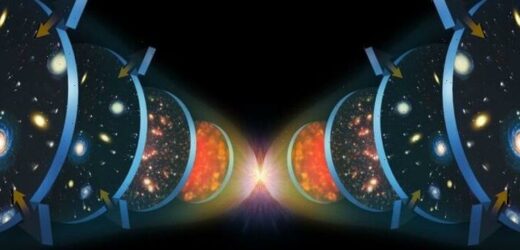Dark matter: Scientists in 'cloud of fog' over enigma
We use your sign-up to provide content in ways you’ve consented to and to improve our understanding of you. This may include adverts from us and 3rd parties based on our understanding. You can unsubscribe at any time. More info
Physicists have determined that the laws of nature tend to follow three fundamental symmetries, that of charge, parity and time, known collectively as CPT symmetry. What this means, in theory, is that if you were to consider the interactions between any particles, you could reverse the charges (switch matter with antimatter, for example); replace every particle, interaction and decay with its mirror image (a so-called parity transformation); or run the interaction backwards instead of forwards in time — and it would still behave the same. In reality, however, things are a little more complicated, as sometimes individual symmetries aren’t followed, in what physicists call a “violation”.
If we take neutrinos, for example — subatomic particles that are similar to electrons, but with no electrical charge and a minimal mass — they are thought to always spin clockwise relative to the direction in which they are travelling.
Physicists call this “left-handedness”; if you hold out your hand with your thumb pointing towards you and your fingers bent, you’ll see that your fingers curl around the thumb’s axis in a clockwise direction.
Because all known neutrinos are left-handed, you can’t perform a parity transformation on them, as the mirror image would be a right-handed neutrino, which doesn’t seem to exist.
Similarly, as antineutrinos are always right-handed, you can’t perform a charge transformation on a neutrino, as you would have to end up with a left-handed antineutrino.
While individual symmetries have been seen to be violated, no system has ever violated all the three parts of CPT symmetry at once — it appears to be fundamental.


In their study, Dr Latham Boyle and his colleagues at the Perimeter Institute for Theoretical Physics in Waterloo, Canada propose extending the scope of CPT symmetry.
They set out to explore whether it might apply not just to basic interactions within the universe, but also to the very universe itself.
According to the trio, the starting point for this thought experiment came from “a simple observation” — that in the hot, radiation dominated era of the early universe that began less than a minute after the Big Bang, the maths describing the background universe has time-reversal symmetry.
They added: “We interpret this as a clue that the state of the universe (i.e. the spacetime itself as well as the quantum state of quantum field theory on that spacetime) might actually respect CPT symmetry.”

The cosmos as we know it evolves forward in time. For CPT symmetry to apply to the universe, therefore, it stands to reason that our understanding of the universe can only be half of the picture — there must be another universe lying on the other side of the Big Bang, one in which time runs in the opposite direction.
In this “mirror” universe, all the particles would have the opposite charge to the prime universe counterparts, appear as if flipped in the mirror and run, from our perspective, “backwards” in time.
While, on their own both our nor the mirror universe violate CPT symmetry, when taken together as a pair, they would obey it.
The team said: “The universe before the bang and the universe after the bang may be viewed as a universe/anti-universe pair, emerging directly into the hot, radiation-dominated era we observe in our past.”

Considering our known cosmos as part of a universe/anti universe pair has some interesting ramifications for our understanding of physics.
To start with, a CPT-respecting universe would naturally expand and fill itself with particles, the researchers explained.
This absolves the need for the so-called “inflationary epoch” in which the universe rapidly expanded for a fraction of a second shortly after the big bang, increasing its volume by a factor of a tredecillion — or “1” followed by 78 zeros.
While there is a lot of evidence to suggest an inflationary event did occur, the models for such all have inherent vagaries — and other interpretations may still be viable.
DON’T MISS:
Putin blinks first: Bumper gas supplies sent to EU [REPORT]
Scientists declare if humanity would survive Russia nuclear war [ANALYSIS]
UK to avoid Putin’s EU energy wrath as huge new gas field found [INSIGHT]
At the same time, a universe that respects CPT would need to have one massless species of neutrino as well as at least one right-handed variety of neutrino — which, as noted earlier, have never been observed.
And if they do happen to exist, right-handed neutrinos, physicists believe, would be abundant but largely undetectable and interact with other particles solely via gravity.
This makes right-handed neutrinos an intriguing candidate for “dark matter”, the mysterious component of the universe whose existence — and gravitational influence — is needed to fully explain the motion of stars within galaxies.
Physicists have estimated that around 27 percent of the universe may be composed of dark matter.

Unlike in the Star Trek franchise, where access to the Mirror Universe — and its proliferation of sinister-looking goatees — is but a transporter malfunction away, we will likely never be able to visit or even directly measure our anti-universe counterpart.
However, the researchers explained, there are ways that we could infer the existence of a real-life mirror universe by studying the properties of our own cosmos.
For example, if our universe has a twin, then we should one day discover that all the presently known neutrinos are their own antiparticles — and, as mentioned above, that one neutrino species is completely massless.
Finally, the twin universe model would mean that space-time was never shaken by inflation, meaning that the ongoing search for primordial gravitational waves — such as is being undertaken by the BICEP experiment at the South Pole — would prove fruitless.
A preprint of the researchers article, which has been accepted for publication in the journal Annals of Physics but has not yet been peer-reviewed, can be read on the arXiv repository.
Source: Read Full Article


